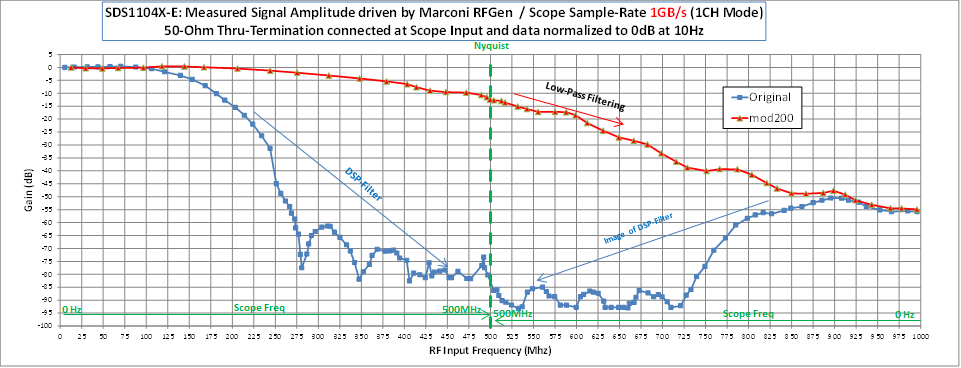@tv84: Thanks for the feedback.
Let me add some more context to my question:
rf-loop did some initial frequency response measurements of the SDS1104X-E in Reply# 808
https://www.eevblog.com/forum/testgear/siglent-sds1204x-e-released-for-domestic-markets-in-china/msg1623214/#msg1623214]http:// [url]https://www.eevblog.com/forum/testgear/siglent-sds1204x-e-released-for-domestic-markets-in-china/msg1623214/#msg1623214[/url]
Performa01 in Reply# 817 followed up with the measurements for a real SDS1202X-E confirming the similar response compared to a mod200 SDS1104.
https://www.eevblog.com/forum/testgear/siglent-sds1204x-e-released-for-domestic-markets-in-china/msg1624003/#msg1624003]http:// [url]https://www.eevblog.com/forum/testgear/siglent-sds1204x-e-released-for-domestic-markets-in-china/msg1624003/#msg1624003[/url]
I am also presuming that the SDS1202X-E has the same front-end as the SDS1204X-E.
In Reply# 829 rf-loop added some great alias tests and confirms by the graphs that the mod200 of the SDS1104X-E does not have much alias rejection.
https://www.eevblog.com/forum/testgear/siglent-sds1204x-e-released-for-domestic-markets-in-china/msg1635386/#msg1635386But the measurements were limited to 500MHz. I was very curious about alias response above 500MHz to see if there is a decent pre-ADC low-pass.
Thus, I did pretty much the same frequency measurements as in Reply# 829 but swept up to 1GHz.

Figure 1:
The graph shows the Frequency response from 5MHz to 1000MHz of the SDS1104X-E using the 2/4-Channels switched to 500MBs. I used the FFT-Mode (MATCH) and put the results into Excel.
The green X-Axis arrows below shows the actual Oscilloscope frequencies (the frequency that the scope shows).
I divided the measurements into four sections (5-250MHz, 250-500MHz,500-750MHz. 750MHz-1000MHz) and patched each Scope-reading (0-250MHz) into the one graph. I flipped the x-Axis of the sections 250MHz-500MHz and 750MHz-1000GHz because an RF input of 251MHz maps to an alias frequency at the scope reading of 249MHz etc..
The blue curve shows the original SDS1104 (out of the box) frequency response from 5MHz to 1000MHz. You can see additional rejection above 100MHz which mirrors at the Nyquist frequency of 250MHz and 750MHz. Because the rejection mirrors at Nyquiwst, it must be a DSP filter (not only the RF inputs mirror at Nyquist, but also any internal DSP filter).
The red curve shows the response after applying the mod200 software change for frequency extension to 200MHz. Since that response shows no mirror-effects (it falls monotonically) there cannot be any DSP filter applied. The rate at which the response includes any filtering applied to prior to the ADC. Because the blue and red curve align, except for the DSP-filter, I am presuming that nothing is switched in the hardware when applying the mod200 software change. Since the red curve resembles earlier measurements of the SDS1202 (Performa01 in Reply# 817),
it kind of proves that the hardware is identical between SDS1104 and SDS1204.
Figure 2:
The graph shows the Frequency response from 5MHz to 1000MHz of the SDS1104X-E using the 2/4-Channels switched to 1GBs. I divided the measurements in two sections (5-500MHz, 500MHz-1000MHz) and patched each Scope-reading (0-500MHz) into the one graph. I flipped the x-Axis of the section 500MHz-1000GHz.
The blue curve shows the original SDS1104 (out of the box) frequency response from 5MHz to 1000MHz. You can see the great rejection above 100MHz which mirrors at the Nyquist frequency of 500MHz.
The red curve shows the response after applying the mod200 software change for frequency extension to 200MHz. Since that response simply falls monotonically there can’t be any DSP filter applied. Because the blue and red curve align, except for the DSP-filter, I am presuming that nothing is switched in the hardware when applying the mod200 software change.
Conclusions:
- The software upgrade mod200 does not seem to switch any input ADC filtering.
- The hardware of the SDS1104 and SDS120X seem to be identical and no matter of license mode.
- In SDS1004 mode, there is a DSP filter above 100MHz which rejects aliasing up to Nyquist and beyond Nyquist because the DSP filter also mirrors around the first Nyquist frequency.
But I am still stuck with my earlier question: Why is the alias frequency rejection of the 200MHz mode so bad? I am not sure if a better (steeper) hardware LPF filter could be designed to reject at least the 500MHz better.
And more importantly: why don’t they not even apply DSP filtering at 1GB/S sample-rate to the SDS1204 (SDS1104 with mod200)?? At 1GB/s sample rate they could have applied the same DSP filter as for the SDS1004 in 500MB/s mode. I would presume that this does not even need a hardware change. What am I missing? What are other Oscilloscopes doing?